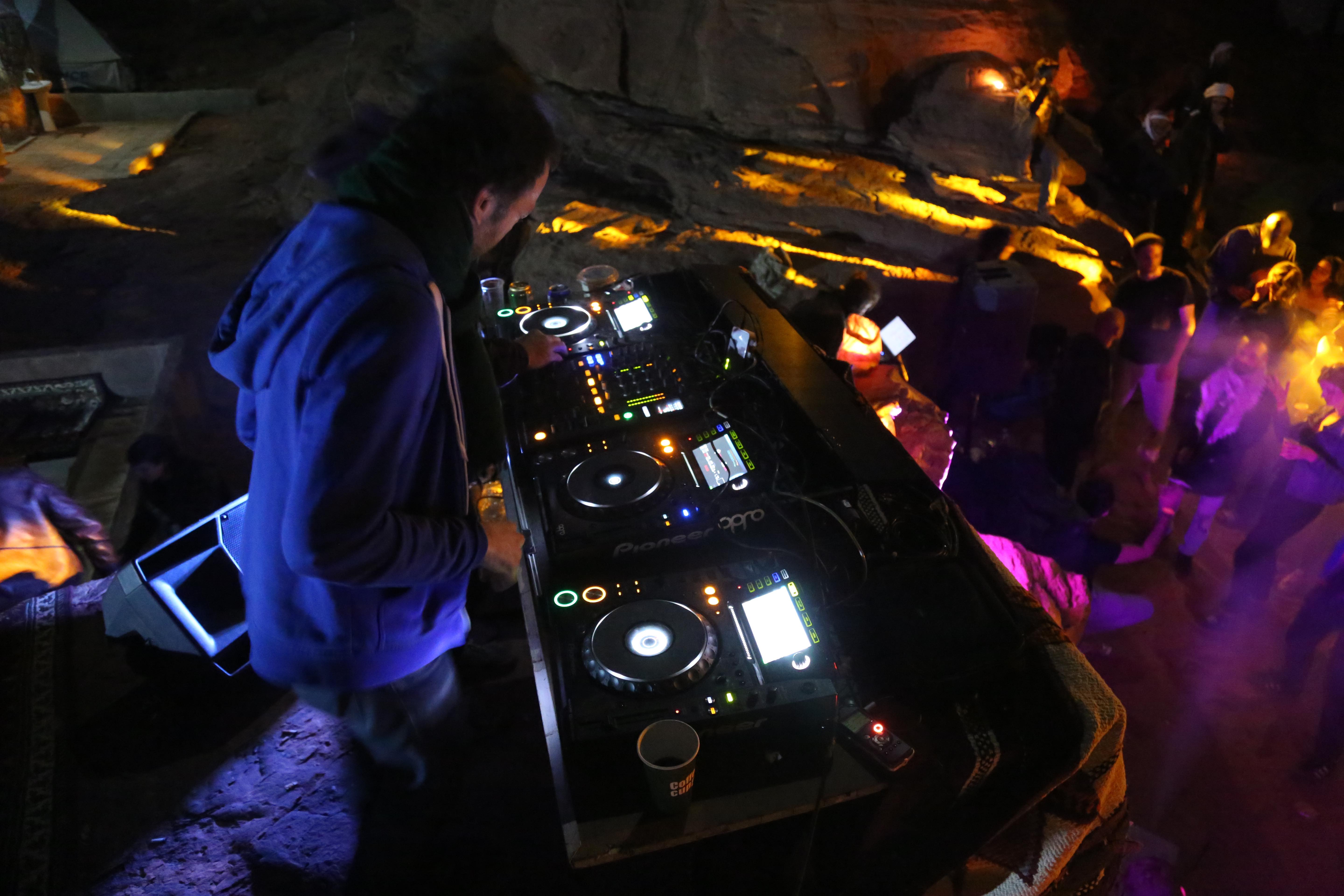Desert raving at Jordan’s first ever Techno festival
- Text by Flora Mory and Laure Van Ruymbeke
- Photography by Flora Mory

Only a few minutes into his set, Shadi Khries suddenly has to fade out his track. The Jordanian DJ and organiser of the first Wadi Rum Electro Festival (WRE) is in distress over flashing blue and red lights that just appeared on the other side of the desert valley. “We have the official authorisation to organise this festival, but I knew there would be trouble,” Shadi says, as his eyes fixate on the lights approaching in the dark.
15 minutes later, a police car pulls up with wailing sirens at the festival site, a Bedouin camp inside Jordan’s Wadi Rum desert. 50 Bedouin men then rush to the police car to show the officers who is in charge. All of them grab each other by the hand and start chanting and dancing the “dahiya” – a traditional Bedouin dance – until the sirens disappear again in the depths of the valley. Then the turntables are turned back on and both the Bedouins and the festival crowd revive the dance floor.
Jordan, a conservative country that borders war-torn Syria, is not your typical festival destination. Nevertheless, 200 techno lovers from around the world flocked to the Wadi Rum desert, a UNESCO protected area, on the last weekend of March to set up tent amidst the mystic red sandstone mountains.


By turning Wadi Rum’s stunning scenery into a stage, DJ and percussionist Shadi Khries was able to convince all of his major collaborators – which includes the Parisian duo Acid Arab, the German techno collective Station Endlos and Cornelius Doctor & Tushen Raï, a duo from Lyon – to join this untypical adventure. After all, they all share a deep appreciation for Middle Eastern music and a curiosity for fusing it with techno beats in ways beyond simply walloping samples over a beat.
“It’s an incredible experience to see Bedouins in their traditional gowns lose it to our remix of a track that we discovered a few years ago in Jordan,” says Acid Arab’s Guido Minisky and Hervé Carvalho. “This encourages us to play songs the audience may know in part, while still making people discover something new.”
Local young Jordanian Fayez al Hwety, for example, tells Huck that the festival is his first exposure to techno music – but he intends to dance to it all night. “Bedouin-style”, he adds with a smile.


For many artists and attendees from abroad, the informal lineup also adds much to the two-day festival’s allure. Bedouins in Wadi Rum, who are all part of the Zalabia tribe, are known for their mastery of centuries-old Arabic instruments, such as the Oud, Rebaba and Darbukka. However, the only occasions to witness Bedouins perform their music traditions are usually Bedouin weddings.
Shadi’s friendship with the Bedouin community of Wadi Rum goes back 15 years, to when Shadi started going to the desert to discover, record and sample their music traditions. For Shadi, now an established DJ in Paris’ nightlife scene in part thanks to those unique samples of traditional Bedouin music, the festival is a way to give back to the Bedouin community. Because of their intimate friendship, a number of Bedouins agreed to take the stage to perform their music tradition, although no one is getting married.
Bedouins in Wadi Rum are used to foreigners. One might say they have become experts in hosting tourists and showing them the desert through climbing, Jeep and camel tours. However, WRE festival is a welcome change from the norm – allowing Bedouins to share their unique, centuries-old music traditions and mingle with electronic music lovers from abroad. “It’s about sharing cultures both ways”, adds Shadi.
Learn more about Wadi Rum Electro Festival on its official Facebook page.
Follow Flora Mory on Twitter.
Enjoyed this article? Like Huck on Facebook or follow us on Twitter.
Latest on Huck

In the ’60s and ’70s, Greenwich Village was the musical heart of New York
Talkin’ Greenwich Village — Author David Browne’s new book takes readers into the neighbourhood’s creative heyday, where a generation of artists and poets including Bob Dylan, Billie Holliday and Dave Van Ronk cut their teeth.
Written by: Cyna Mirzai

How Labour Activism changed the landscape of post-war USA
American Job — A new exhibition revisits over 70 years of working class solidarity and struggle, its radical legacy, and the central role of photography throughout.
Written by: Miss Rosen

Analogue Appreciation: Emma-Jean Thackray
Weirdo — In an ever more digital, online world, we ask our favourite artists about their most cherished pieces of physical culture. Today, multi-instrumentalist and Brownswood affiliate Emma-Jean Thackray.
Written by: Emma-Jean Thackray

Meet the shop cats of Hong Kong’s Sheung Wan district
Feline good — Traditionally adopted to keep away rats from expensive produce, the feline guardians have become part of the central neighbourhood’s fabric. Erica’s online series captures the local celebrities.
Written by: Isaac Muk

How trans rights activism and sex workers’ solidarity emerged in the ’70s and ’80s
Shoulder to Shoulder — In this extract from writer Jake Hall’s new book, which deep dives into the history of queer activism and coalition, they explore how anti-TERF and anti-SWERF campaigning developed from the same cloth.
Written by: Jake Hall

A behind the scenes look at the atomic wedgie community
Stretched out — Benjamin Fredrickson’s new project and photobook ‘Wedgies’ queers a time-old bullying act by exploring its erotic, extreme potential.
Written by: Isaac Muk